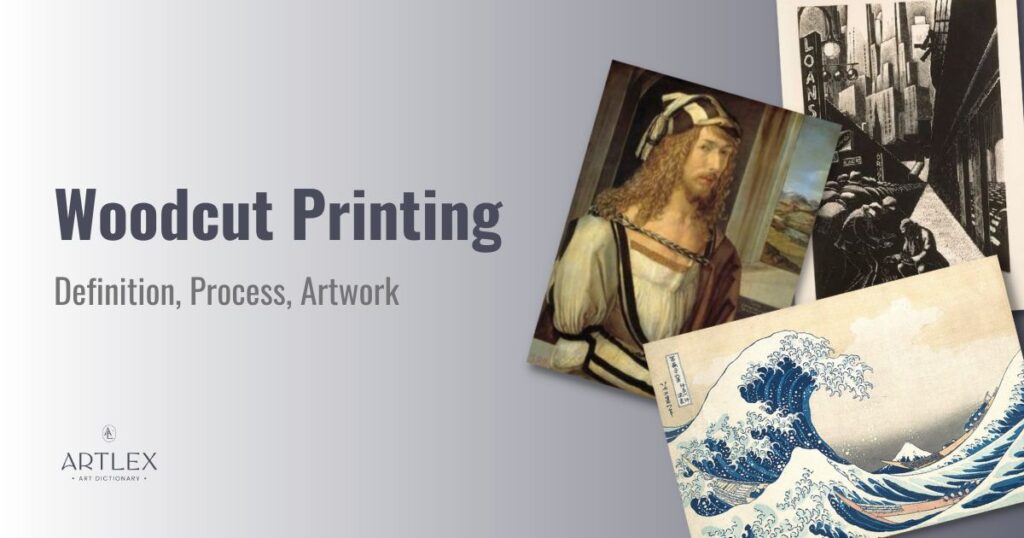
Woodcut printing is the oldest form of printmaking that spans both centuries and cultures. Woodcut is a type of relief printing made through a simple process of carving a wooden block, applying ink, and then pressing paper to the wooden block to create an image.
While the earliest evidence of woodblock printing has been found in Ancient China, woodblock printing is a form of art that has developed throughout the world.
Though the medium is rigid, woodblock printing has served numerous creative and literary purposes throughout the millennia. It is a flexible medium that can create powerful images.
Woodcut printmaking falls into the category of relief printing because the raised surface left after carving produces the images. However, woodcut printmaking is not the only type of relief print. There is also wood engraving, rubber/metal stamping, linoleum cuts, and letterpress.
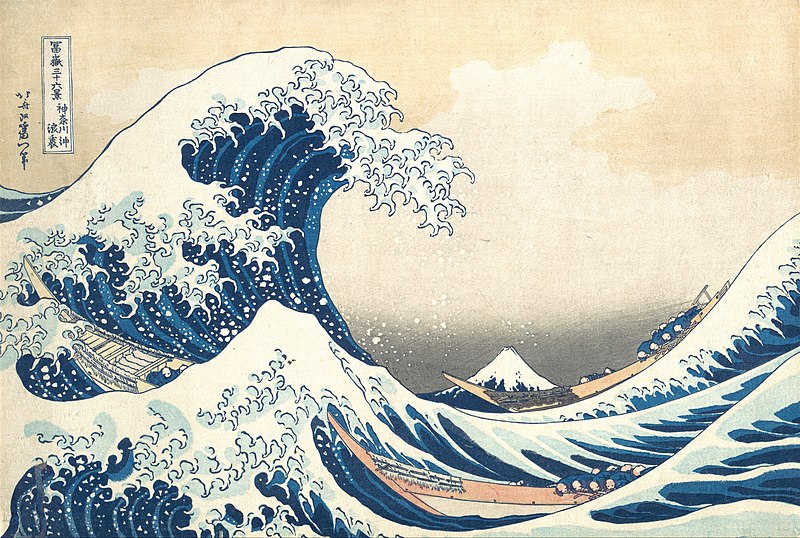
How Are Woodcut Prints Made?
Depending on the level and style of woodcut printmaking you’re interested in, the art of woodcut printing can be simple or complicated.
Many modern Japanese woodcut printmaking artists still work in their homes, sitting on the floor to carve and print. This process requires minimal tools. A flat tool made of bamboo, known as a baren, is used to apply pressure. The artists lay the paper on the inked woodcut and rub it evenly until the print is complete.
In both Western and Eastern woodcut printmaking, a larger-scale woodcut operation requires multiple people. The artist, of course, must create the original design. This leads to a collaboration between studio printers, carvers, artists, and the publisher. Printing presses are used to create woodcuts on a larger scale.
The results of woodcut printmaking can vary, but generally, the carving process lends to strong, graphic elements within the artwork. Woodcuts can be highly detailed though wood engraving is more suitable for highly-detailed works. Overall, woodcut is a versatile and historical medium that produces bold, meaningful art.
How Is Woodcut Printing Different From Other Forms of Printmaking?
Woodcut is a unique medium in its simplicity and how challenging the material is. Original woodblock prints can potentially crack when pushed through a printing press. In its earliest stages, woodcut was a monochrome printing medium. During the 1700s, however, new technology introduced layers of color to this type of relief printmaking.
The closest cousin to woodcut is wood engraving. The difference here is that artists can create more nuanced, detailed images than with a traditional woodcut. For engraving, the artist cuts into the grain of the wood rather than along it.
Intaglio is perhaps the opposite of woodcut. Intaglio entails the artist carve or etch directly into the plate surface. This results in ink filling the empty spaces rather than ink sitting on the raised surface.
Other printmaking methods, such as screen printing, work differently from carved blocks. For these methods, there is no carving, and artists produce prints through stencil or chemical processes.
The Origins of Woodcut Printing
Woodcut printing has such a long and rich history it can be difficult to decipher what was happening and when. The most important thing to understand is that woodcut artists worldwide have greatly influenced and challenged each other throughout history.
Woodcut In Asia 200 BCE – 1600
While the Japanese are known for perfecting the art of woodblock printing, the first evidence of using wooden stamps and woodcut blocks lies in Ancient China. Between 200 BCE – 200 CE, the Chinese developed paper made from wood around the same time as woodblock prints. As early as 650 CE, they produced print books of Buddhist scripture with the woodcut medium.
Around when the Chinese began producing these books, the medium became widespread in Japan. The Japanese used woodcut printing to disseminate texts for several centuries. The Edo period (approximately 1600-1850) produced many well-known historical woodcut artists from Japan. One of the first polychrome woodcut prints was commissioned in Edo.
Woodcut Art in the Western World 1400s-Present
With the advent of the printing press, woodcuts became even more popular and widespread–for a period. Metal etching dominated for the next few hundred years.
After a lull, woodcut printmaking became popular again with an innovation in color application. Artists like Albrecht Durer defined the medium of European woodcut prints during the 1700s. The following two hundred years saw innovations that would redefine woodcut. People used woodcuts to convey texts and information up to this point, but the advent of polychrome woodcuts crystallized it as a creative medium.
From the 1600s forward, woodcut solidified its place in the world of creation with familiar artists like Albrecht Durer and Hokusai. Like so many art mediums, woodcut was replaced in popularity by wood engraving circa the 19th century. Because wood engraving uses a woodblock cut against the wood grain rather than along it, the surface enables much higher detail work.
The Significance of Woodcut Printing In The Creative World
Even when woodblock was primarily used to convey texts, scriptures, and information, creative elements reigned. Combining illustrations or symbols with text was common, and carving is an ancient form of human expression.
Perhaps one of the most beautiful things about woodcut art is the exchange between cultures. Both the late Hokusai and modern woodcut artist Haruyo Morita made a point of traveling the world and educating themselves in various venues.
European and American artists, in turn, have been heavily influenced by Asian woodcut artists.
Woodcut printing is also an extremely accessible art form. In general, the materials are inexpensive, and you don’t need much space. The best part is you can carve once and then create endless artwork from one woodblock.
What are Ukiyo-e Woodcut Prints?
When reading about woodcut printing, you may often come across the term “ukiyo-e.” Ukiyo-e was the prominent art style and subject matter throughout the Edo Period.
Ukiyo-e is tied to woodcut printing’s history of addressing the poor, mundane, and every day. These woodcut prints were depictions of people going about their usual lives, imbued with wistfulness and creative fancy.
Hokusai and other Japanese artists carried on the tradition of ukiyo-e by paying attention to all types of people as artistic subjects–prostitutes, laborers, and kabuki actors. Even today, artists from all over the world still employ this style when making woodcut prints.
The Woodcut Printing Process – How To Make Your Very Own Woodcut Block
Woodcut printing is so popular and widespread because it uses common materials, and you don’t necessarily need a large space. You will need a few items to get going, but if you purchase the right materials, they can last for years.
Making your woodcut block print is a multi-step process. Once you discover the techniques, you can let your creativity flourish!
Here is a basic list of everything you’ll need to get started with woodcut printing.
- Woodblock(s)
- Chisels
- Paint/ink
- Drawing tools
- Paper
- Ink roller
- A baren or something to apply pressure with
Step 1 – Prepare All of Your Materials
When working with woodcuts, keep all your tools close at hand and in good condition. Nothing could be more frustrating than getting in the flow only to realize you can’t find a certain chisel.
Chisels are a unique tool to be used with care. If you enjoy woodblock carving, it is worth investing in high-quality tools that can last you a lifetime. Because chisels are sharp, they shouldn’t be left out where pets or children can access them.
The type of wood you use will likely depend on what is available at your local art store. Woodblocks made from plywood and pear are the most common, but cherry and birch are also available.
Your workspace for woodcut printing should be comfortable and undisturbed. Ideally, you should have some room to spread out and make a bit of a mess.
Step 2 – Practice Carving on a Scrap Woodblock
Getting to know your tools and materials is an essential step in learning a new artistic medium. Trying to make a masterpiece right away often results in frustration or broken materials.
Different chisels will result in different markings on your woodcut. Once you’re carving your final piece, you will know just what tool you need if you’ve already practiced.
Use a less-attractive woodblock to practice your printmaking techniques and familiarize yourself with your tools.
Step 3 – Conceptualize Your Artwork
The first stage of the woodcut process is having an idea of what image you want to create. Since wood can be a tricky medium to carve into, creating a picture that suits the material will result in a better experience overall.
You can sketch thumbnails of your art out first to decide exactly how you want it to look. Then, sketch your idea directly onto the surface of your woodblock. Or, if you want to use your original sketch, you can use a method such as a Wintergreen Transfer to get your work directly onto the block.
The other option is to let your imagination go wild and start sketching or carving right into the woodblock. This can be a little risky but also fun. Just remember the quality of the woodblock you’re carving into–carving with the grain sometimes means that big chunks can break off.
Step 4 – Begin Carving Your Woodblock
This is the part you’ve been waiting for: time to create some beautiful art!
One of the best ways to learn to carve is to not only practice but watch the masters at their practice. The more techniques you know, the more creative you can get while carving.
Some woodcut artists like to begin with a frame around all four sides of the woodblock to “contain” their image. This can provide guidance and help you avoid the fear of making the first cut.
You will be grateful for your practice here. Working with negative space can feel different from 2D mediums or sculptures.
Step 5 – Apply Your Ink to the Woodblock
This stage of woodcut requires attention to detail. Too much ink will cause your print to come out blotchy and messy. Too little ink will result in a faded image. The first few prints may look less-than-perfect, but keep practicing.
Use a smooth, steady back-and-forth motion to apply ink for an even application.
A little goes a long way with printing ink, typically. Once you’re comfortable in knowing how much ink you need, you can start experimenting with different color combinations.
Step 6 – Make Your Woodcut Print
The trickiest part here is getting your woodblock and paper aligned evenly. You can use pencil marks, a ruler, or tape on an appropriate surface to align your woodblock and paper.
Carefully lay your paper over your inked woodblock. If you don’t have a baren, use the back of a cooking spoon, a flat polished stone, or even your hands to rub the back of the paper into the print.
Make sure to apply even pressure across the entire surface. Or you can play around with higher pressure in some areas and lower in others, creating a faded effect. Once you’re confident that the print has been transferred, peel the paper away from the woodblock from top to bottom. Hold both top corners of the paper to ensure it doesn’t slip around.
Step 7 – Admire Your Woodcut Print
Now, you have your final print! The beauty of woodcut printing is that you can make endless prints of your artwork. Additionally, if you’re not happy with your print or want something fresh, you can always re-use the wood and carve something abstract into it.
You can also color or paint into your existing woodcut art to make them more personalized and unique. This versatile medium is not only challenging and enjoyable, but it can also supply you with all the gifts you need for family and friends!
What Does Woodcut With a Printing Press Look Like?
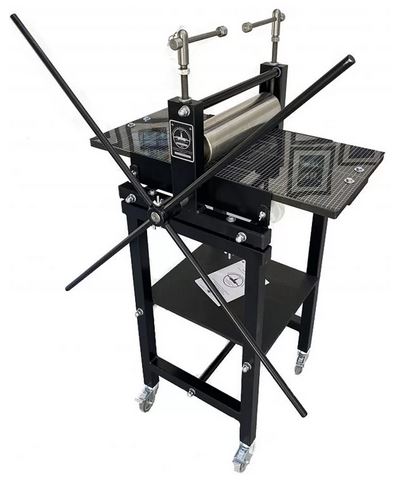
Woodcut printing in the studio with a printing press is similar to doing it at home, but on a larger scale and with more machinery. With these machines, you can create prints on a larger scale. Full-size printing presses are powerful machines with printing processes that can potentially be dangerous. Never use a printing press without a trained professional or teacher nearby.
Water-based inks are preferable for home use because they tend to be safe for pets and children. In a studio, oil-based printing inks are more common because they tend to last longer and have a higher visual quality.
Modern Japanese woodcut artists still use a traditional method of mixing rice paste into their ink. This serves as a distributor and spreads the ink more evenly. The use of this ancient method also gives Japanese woodcut prints their distinctive muted palette.
The process of woodcut printing is similar up until the creation of the print. Large-scale woodcut printing involves teams of several people. The artist, of course, conceptualizes the art. Because large-scale printing presses are expensive machines, a publisher who owns the machine and space is often involved as well. In some cases, other carvers are employed to create more base woodblocks. Finally, the printmakers finalize the process by using the press to create the prints.
The Art and Artists of Woodcut Printing
Several artists throughout time and the world have marked definitive eras in relief printmaking. From Albrecht Durer to Lu Xun to Kitagawa Utamaro, diverse woodcut artists have influenced both creative and social movements.
Because of its mass producibility, woodcut printing has been influential in the sharing of information throughout human history. The lines of artist and social activist sometimes overlap, and several forms of printmaking have been involved in this.
Lu Xun
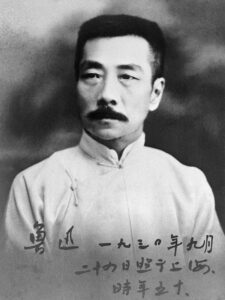
The story of woodcut printing in China is long and complicated. Though the form originated in China, by the time the era of Lu Xun arrived, woodcut as a Chinese creation had been forgotten.
Lu Xun was an artist, writer, and doctor whose woodcut prints inspired free thought during the 1930s and 40s in China. He was passionate about the spreading of information and used the woodcut medium to do so.
Lu Xun’s woodcuts are highly graphic in visual nature. He did not shy away from disturbing and difficult subjects of the Chinese working class. Through his fierce honesty and artwork, Lu Xun inspired artists to pay attention to the plight of the poor.
Woodcut printing is not just a medium meant to convey beautiful images but to share meaningful, life-changing ideas.
Katsushika Hokusai
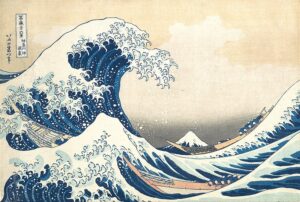
One would be remiss to discuss woodblock art without addressing Katsushika Hokusai, more widely known as Hokusai.
Almost everyone has seen “The Great Wave of Kanagawa.” This print has made its way around the world, but Hokusai was an artist with a much wider body of work. He also made silkscreen prints and paintings.
Hokusai’s influence is perhaps because of his immense productivity. Throughout his career, Hokusai produced approximately 30,000 illustrations for at least 500 books. He was one of the prominent artists in the late Edo period; his artwork was definitive of the ukiyo-e style.
Hokusai traveled all over the globe to develop his art and evolved throughout his career. No wonder this influential artist inspired such names as Vincent Van Gogh and Paul Gauguin.
Haruyo Morita

Japanese woodcut artists are still going strong in the modern world. Many still use traditional methods, even if they reside and make their art in other places in the world.
Haruyo Morita is a contemporary woodcut artist hailing from Kita-Katsushika County, Saitama Prefecture, Japan. She is famous for colorful woodcut prints in the ukiyo-e style, doing homage to past eras of Japanese history.
Morita has followed in Hokusai’s footsteps by showing her work worldwide, including Saudi Arabia, Tokyo, London, Honolulu, and many more.
Clare Leighton
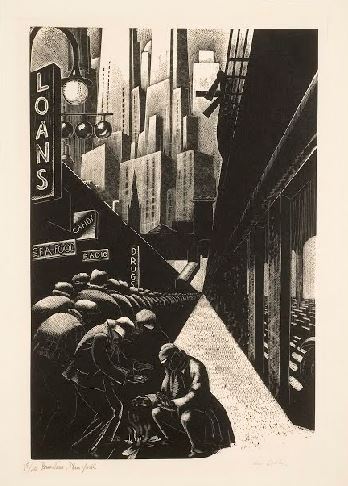
Though Clare Leighton did not inspire social movements the way Lu Xun did, she is another socially significant woodcut artist.
Leighton was the first woman to publish a book about the process and art of woodcut printing. Encouraged as an artist in her youth, she went to the Slade School of Fine Art in the 1920s to hone her skills. Leighton discovered her love for woodcutting and quickly advanced in the medium. By 1921, she was showing woodcut art in the annual exhibition by the Society of Wood Engravers.
Leighton’s artworks like “The Quay: Dalmatian Village” show her bold style and excellent eye for composition.
Albrecht Durer
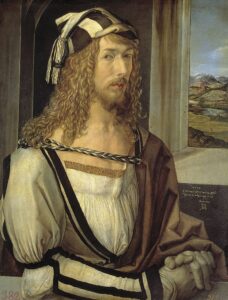
Few artists have had such widespread influence as Albrecht Durer. His name is still present in art schools and facilities around the world.
Durer’s highly detailed and meticulous style challenged the woodcut medium and redefined the aesthetic for which printmakers strove. He created at least 300 woodcuts in his life, often of large scale and always of incredible detail.
Other artists could only hope to imitate the high quality of Durer’s woodcut prints. “The Last Supper,” created in 1510, is Durer’s interpretation of the classic scene. The detail on the walls imitates sunlight radiating from the center of Jesus’s head. One can only imagine how many hours Durer must have spent perfecting this and other pieces like it.
The Worldwide Picture of Woodcut Printing
The definition of woodcut printing is expansive and historical. This limited yet versatile medium conveyed information between humans for hundreds of years, whether through scripture, books, or images. Though woodcut’s popularity as a mass-production medium has waxed and waned since its creation in ancient China, woodcut persists as a beloved creative art to this day.
Artists of history used woodcut art to express their creativity and spread important ideological messages. Huge names like Hokusai, Albrecht Durer, and Lu Xun used the medium to influence artistic and political movements.
Woodcut is an affordable form of art that is accessible to people everywhere. With some supplies and determination, anyone can make a series of woodblock prints. If you discover a passion for woodcuts, you can find a professional studio with a full-sized press that will open a whole new world of printmaking.
